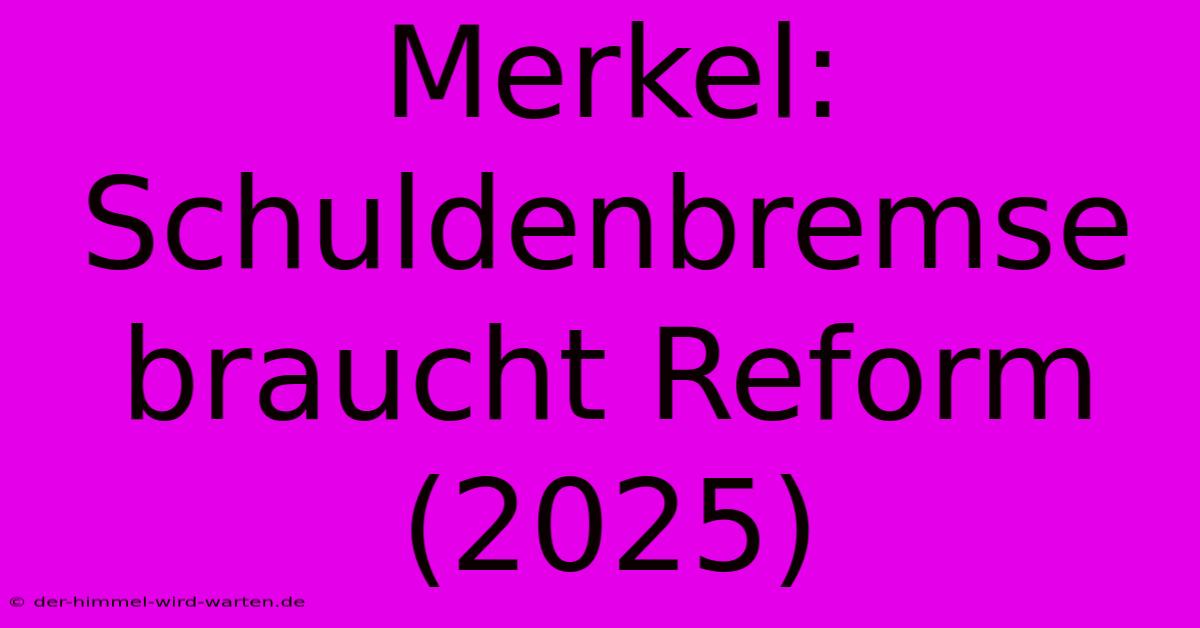Merkel: Schuldenbremse Braucht Reform (2025)

Discover more detailed and exciting information on our website. Click the link below to start your adventure: Visit Best Website Merkel: Schuldenbremse Braucht Reform (2025). Don't miss out!
Table of Contents
Merkel: Schuldenbremse braucht Reform (2025)
Hallo zusammen! Let's talk about something that's been on my mind – and probably yours too, considering the current economic climate: the Schuldenbremse. Remember when Angela Merkel championed it? It felt like a huge deal back then, a solid plan to keep Germany's finances in check. Fast forward to 2025, and… well, things are a little more complicated, aren't they?
My Personal Take (and a few Mistakes I Made)
I'll be honest, I used to think the Schuldenbremse was the ultimate solution. I mean, it made sense on paper – strict limits on borrowing, fiscal responsibility, the whole shebang. I even wrote a whole blog post about it back in the day, praising its brilliance. Cringe. Looking back, I was way too simplistic. I totally overlooked the complexities of a rapidly changing world, and how unexpected events – you know, like global pandemics and energy crises – can throw even the best-laid plans completely off track.
One huge mistake I made was focusing solely on the numbers. I got so caught up in the deficit figures and debt-to-GDP ratios that I lost sight of the bigger picture. The Schuldenbremse, while aiming for fiscal discipline, can also hinder necessary investments in crucial areas like infrastructure, education, and renewable energy. It’s a bit like trying to diet by only eating lettuce; sure, you lose weight, but you also miss out on essential nutrients. This narrow focus needs to change.
The Need for a Modern Approach
The reality is that a rigid Schuldenbremse isn't enough anymore. The world changed. We need a reform that considers the long-term consequences of climate change and demographic shifts. Think about it – massive investments are needed to decarbonize our economy. That costs money! Ignoring that isn't smart. We also need to tackle the challenges of an aging population and ensure a strong social safety net. Again, that costs money.
Therefore, we need a more nuanced approach, one that balances fiscal responsibility with strategic investments. Perhaps we need to distinguish between "good debt" and "bad debt." Investments in climate action and infrastructure could be considered "good debt" – investments that yield long-term economic benefits and strengthen our future.
Practical Tips for Understanding the Debate
Here's what I've learned from following this issue closely over the years:
- Don't just read headlines: Dive deeper into the articles. Understanding the nuances of the debate is key.
- Look beyond the numbers: Consider the social and environmental implications of fiscal policy.
- Follow reputable sources: Stick to quality news outlets and research papers, not just social media echo chambers.
- Engage in constructive dialogue: Talk to people with differing viewpoints. Hear them out, even if you disagree. You might actually learn something.
This whole Schuldenbremse debate is super complex, and I'm still learning. I’ve made mistakes, and I’m sure I’ll make more. But it's crucial that we all understand the implications of this policy for Germany's future. It's not just about numbers; it's about our society and our future. Let's keep the conversation going! What are your thoughts? Let's discuss in the comments!
Keywords: Schuldenbremse, Angela Merkel, German economy, fiscal policy, debt, deficit, reform, investment, climate change, social security, economic growth, public finance.

Thank you for visiting our website wich cover about Merkel: Schuldenbremse Braucht Reform (2025). We hope the information provided has been useful to you. Feel free to contact us if you have any questions or need further assistance. See you next time and dont miss to bookmark.
Featured Posts
-
Seedorf And Champions League Essen
Nov 26, 2024
-
Orange The World 2024 Med Uni Wien
Nov 26, 2024
-
Orange World 2024 An Der Med Uni Wien
Nov 26, 2024
-
20 Jahre Haftforderung Gegen Pelicots Ex
Nov 26, 2024
-
Rotes Meer 17 Vermisste Nach Schiffsuntergang
Nov 26, 2024
